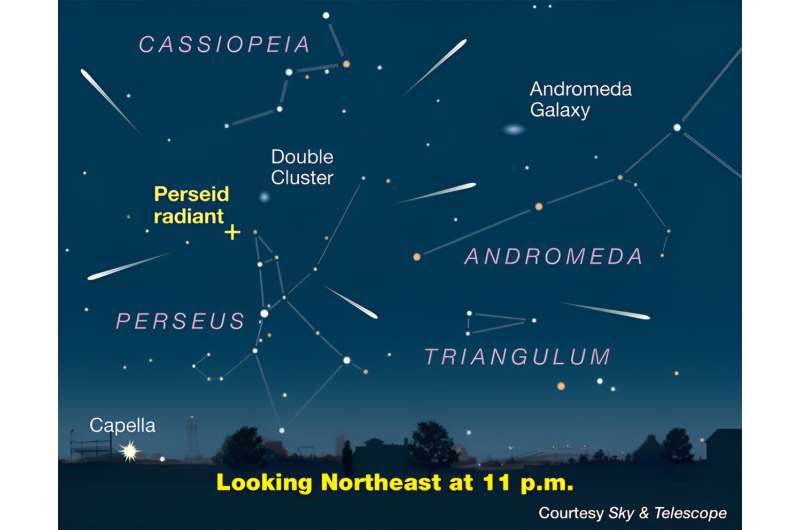
The Perseid meteor shower, a highly anticipated celestial event for skywatchers worldwide, is set to make its annual return to the night sky. The shower is expected to peak before dawn on Sunday, August 13, with meteors potentially visible from nightfall on Saturday, August 12. On a clear night, away from light pollution, observers may see up to one meteor per minute during the peak.
“Conditions for viewing the Perseid meteor shower this year couldn’t be more perfect,” according to Diana Hannikainen, Observing Editor for Sky & Telescope. “The waning crescent moon, which is only 8% illuminated, will rise in the early hours of August 13 and will not interfere with viewing.” Hannikainen cautions that clouds or light pollution could hinder the enjoyment of the spectacle.
Begin observing for meteors shortly after dusk on August 12. By this time, the shower’s radiant point in the constellation Perseus will have risen above the northeastern horizon. The early Perseids will be particularly long “earthgrazers” that skim along the top of the atmosphere. As Perseus climbs higher in the northeast, especially after midnight, more meteors will become visible throughout the entire sky. The Perseids are a long-lasting event, and meteors can be seen, although in lesser numbers, for several nights before and after the peak.
To enjoy the Perseids, no equipment other than your eyes is necessary. Binoculars and telescopes are not useful for meteor-watching as they have limited visibility. Find a dark location away from bright lights, with an unobstructed view all around if possible. To fully enjoy the show, it is recommended to bring a reclining lawn chair or picnic blanket for a comfortable viewing position. It is also advised to bundle up in blankets or a sleeping bag to shield from mosquitoes and the potential cold of clear nights in August. Relax, be patient, and allow your eyes to adjust to the darkness.
The “shooting stars” can appear anywhere in the sky, so there is no need to focus solely on the radiant. The best direction for observing is wherever the sky is darkest, which is usually straight up. Faint Perseids will appear as quick streaks, while brighter ones may sail across the sky for several seconds, leaving a trail of glowing smoke.
If you spot a meteor, trace its path back to its origin. If the trail leads to the constellation Perseus, you have witnessed a Perseid meteor. Occasionally, you may see meteors from other showers such as Delta Aquariid and Kappa Cygnid, or sporadic meteors from different parts of the sky. It can be a fun exercise to trace these meteors back to their radiants and determine their origin.
Light pollution and cloudiness can reduce the number of visible meteors. However, the brightest Perseids can still shine through light pollution. In fact, a NASA analysis of all-sky images has shown that the Perseids produce more bright meteors (those that outshine any star) than any other annual meteor shower.
How and why
Meteors are created when small specks of dusty debris, ranging from the size of a grain of sand to a pea, collide with the Earth’s atmosphere approximately 80 miles (130 km) above the surface. Each Perseid meteor travels at a speed of 37 miles per second, glowing as it burns and leaving a quick, white-hot streak of superheated air. The characteristics of typical meteor-shower particles closely resemble the size, color, and texture of the nuggets found in Grape Nuts cereal.
The Perseid debris was shed by Comet Swift-Tuttle and is dispersed along the comet’s orbital path around the sun. Earth passes through this sparse “river of rubble” every year in mid-August. The comet is named after Lewis Swift and Horace Parnell Tuttle, who independently discovered it in July 1862.
Provided by
American Astronomical Society
Citation:
A banner year for the Perseid meteor shower (2023, August 7)
retrieved 7 August 2023
from https://phys.org/news/2023-08-banner-year-perseid-meteor-shower.html
This document is subject to copyright. Apart from any fair dealing for the purpose of private study or research, no
part may be reproduced without written permission. The content is provided for information purposes only.
Denial of responsibility! TechCodex is an automatic aggregator of the all world’s media. In each content, the hyperlink to the primary source is specified. All trademarks belong to their rightful owners, and all materials to their authors. For any complaint, please reach us at – [email protected]. We will take necessary action within 24 hours.

Jessica Irvine is a tech enthusiast specializing in gadgets. From smart home devices to cutting-edge electronics, Jessica explores the world of consumer tech, offering readers comprehensive reviews, hands-on experiences, and expert insights into the coolest and most innovative gadgets on the market.


